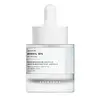What's inside
What's inside
 Key Ingredients
Key Ingredients

 Benefits
Benefits

 Concerns
Concerns

No concerns
 Ingredients Side-by-side
Ingredients Side-by-side

Water
Skin ConditioningButylene Glycol
HumectantGlycerin
HumectantDipropylene Glycol
HumectantDimethicone
EmollientMaltitol
HumectantErythritol
HumectantTranexamic Acid
AstringentTrehalose
HumectantXylitol
HumectantPEG-12 Dimethicone
Skin ConditioningPhenoxyethanol
PreservativeDiphenylsiloxy Phenyl Trimethicone
Skin ConditioningCarbomer
Emulsion StabilisingAcrylates/C10-30 Alkyl Acrylate Crosspolymer
Emulsion StabilisingDipotassium Glycyrrhizate
HumectantPotassium Hydroxide
BufferingXanthan Gum
EmulsifyingSodium Metaphosphate
BufferingSodium Methyl Stearoyl Taurate
CleansingSaccharomyces Ferment Lysate Filtrate
Skin ConditioningSodium Metabisulfite
AntioxidantGarcinia Mangostana Bark Extract
Skin ConditioningLysine Hcl
Skin ConditioningPEG/PPG-14/7 Dimethyl Ether
Skin ConditioningAesculus Hippocastanum Seed Extract
Skin ConditioningTocopherol
AntioxidantCrataegus Monogyna Flower Extract
Skin ConditioningWater, Butylene Glycol, Glycerin, Dipropylene Glycol, Dimethicone, Maltitol, Erythritol, Tranexamic Acid, Trehalose, Xylitol, PEG-12 Dimethicone, Phenoxyethanol, Diphenylsiloxy Phenyl Trimethicone, Carbomer, Acrylates/C10-30 Alkyl Acrylate Crosspolymer, Dipotassium Glycyrrhizate, Potassium Hydroxide, Xanthan Gum, Sodium Metaphosphate, Sodium Methyl Stearoyl Taurate, Saccharomyces Ferment Lysate Filtrate, Sodium Metabisulfite, Garcinia Mangostana Bark Extract, Lysine Hcl, PEG/PPG-14/7 Dimethyl Ether, Aesculus Hippocastanum Seed Extract, Tocopherol, Crataegus Monogyna Flower Extract
Water
Skin ConditioningButylene Glycol
HumectantHydrogenated Polyisobutene
EmollientGlycerin
Humectant1,2-Hexanediol
Skin ConditioningGlyceryl Stearate Se
EmulsifyingCetearyl Alcohol
EmollientSorbitan Stearate
EmulsifyingCarbomer
Emulsion StabilisingCetearyl Olivate
Sorbitan Olivate
EmulsifyingTromethamine
BufferingSodium Lactate
BufferingInulin Lauryl Carbamate
Emulsion StabilisingPolysorbate 20
EmulsifyingHydrolyzed Sponge
Skin ConditioningAdenosine
Skin ConditioningDisodium EDTA
Hydrolyzed Hyaluronic Acid
HumectantAnemarrhena Asphodeloides Root Extract
Skin ConditioningPalmitoyl Tripeptide-1
Skin ConditioningPalmitoyl Tetrapeptide-7
Skin ConditioningPanthenol
Skin ConditioningMadecassoside
AntioxidantCentella Asiatica Extract
CleansingWater, Butylene Glycol, Hydrogenated Polyisobutene, Glycerin, 1,2-Hexanediol, Glyceryl Stearate Se, Cetearyl Alcohol, Sorbitan Stearate, Carbomer, Cetearyl Olivate, Sorbitan Olivate, Tromethamine, Sodium Lactate, Inulin Lauryl Carbamate, Polysorbate 20, Hydrolyzed Sponge, Adenosine, Disodium EDTA, Hydrolyzed Hyaluronic Acid, Anemarrhena Asphodeloides Root Extract, Palmitoyl Tripeptide-1, Palmitoyl Tetrapeptide-7, Panthenol, Madecassoside, Centella Asiatica Extract
Ingredients Explained
These ingredients are found in both products.
Ingredients higher up in an ingredient list are typically present in a larger amount.
Butylene Glycol (or BG) is used within cosmetic products for a few different reasons:
Overall, Butylene Glycol is a safe and well-rounded ingredient that works well with other ingredients.
Though this ingredient works well with most skin types, some people with sensitive skin may experience a reaction such as allergic rashes, closed comedones, or itchiness.
Learn more about Butylene GlycolCarbomer is a polymer of acrylic acid. Its main role is to create a gel consistency.
A high amount of carbomer can cause pilling or balling up of products. Don't worry, most products contain 1% or less of carbomer.
Glycerin is already naturally found in your skin. It helps moisturize and protect your skin.
A study from 2016 found glycerin to be more effective as a humectant than AHAs and hyaluronic acid.
As a humectant, it helps the skin stay hydrated by pulling moisture to your skin. The low molecular weight of glycerin allows it to pull moisture into the deeper layers of your skin.
Hydrated skin improves your skin barrier; Your skin barrier helps protect against irritants and bacteria.
Glycerin has also been found to have antimicrobial and antiviral properties. Due to these properties, glycerin is often used in wound and burn treatments.
In cosmetics, glycerin is usually derived from plants such as soybean or palm. However, it can also be sourced from animals, such as tallow or animal fat.
This ingredient is organic, colorless, odorless, and non-toxic.
Glycerin is the name for this ingredient in American English. British English uses Glycerol/Glycerine.
Learn more about GlycerinWater. It's the most common cosmetic ingredient of all. You'll usually see it at the top of ingredient lists, meaning that it makes up the largest part of the product.
So why is it so popular? Water most often acts as a solvent - this means that it helps dissolve other ingredients into the formulation.
You'll also recognize water as that liquid we all need to stay alive. If you see this, drink a glass of water. Stay hydrated!
Learn more about Water